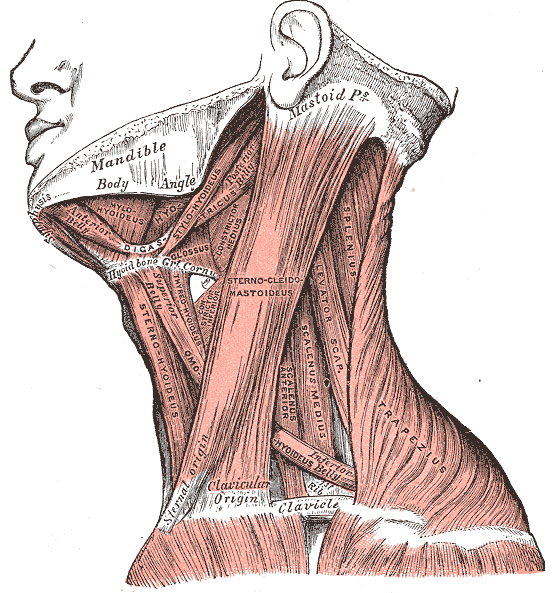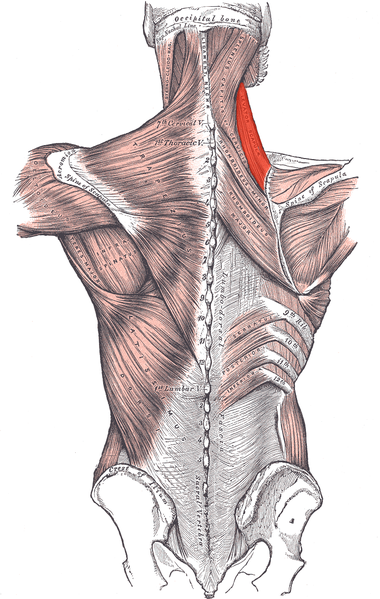[1]
Anderson WS, Lawson HC, Belzberg AJ, Lenz FA. Selective denervation of the levator scapulae muscle: an amendment to the Bertrand procedure for the treatment of spasmodic torticollis. Journal of neurosurgery. 2008 Apr:108(4):757-63. doi: 10.3171/JNS/2008/108/4/0757. Epub
[PubMed PMID: 18377256]
[3]
Oladipo GS, Aigbogun EO Jr, Akani GL. Angle at the Medial Border: The Spinovertebra Angle and Its Significance. Anatomy research international. 2015:2015():986029. doi: 10.1155/2015/986029. Epub 2015 Oct 7
[PubMed PMID: 26523233]
[4]
Vetter M,Charran O,Yilmaz E,Edwards B,Muhleman MA,Oskouian RJ,Tubbs RS,Loukas M, Winged Scapula: A Comprehensive Review of Surgical Treatment. Cureus. 2017 Dec 7;
[PubMed PMID: 29456903]
[5]
Ihnatsenka B, Boezaart AP. Applied sonoanatomy of the posterior triangle of the neck. International journal of shoulder surgery. 2010 Jul:4(3):63-74. doi: 10.4103/0973-6042.76963. Epub
[PubMed PMID: 21472066]
[6]
Frank RM, Ramirez J, Chalmers PN, McCormick FM, Romeo AA. Scapulothoracic anatomy and snapping scapula syndrome. Anatomy research international. 2013:2013():635628. doi: 10.1155/2013/635628. Epub 2013 Nov 28
[PubMed PMID: 24369502]
[8]
Eliot DJ, Electromyography of levator scapulae: new findings allow tests of a head stabilization model. Journal of manipulative and physiological therapeutics. 1996 Jan;
[PubMed PMID: 8903697]
[9]
Bishop KN, Varacallo M. Anatomy, Shoulder and Upper Limb, Dorsal Scapular Nerve. StatPearls. 2023 Jan:():
[PubMed PMID: 29083775]
[10]
Goto H,Kimmey SC,Row RH,Matus DQ,Martin BL, FGF and canonical Wnt signaling cooperate to induce paraxial mesoderm from tailbud neuromesodermal progenitors through regulation of a two-step epithelial to mesenchymal transition. Development (Cambridge, England). 2017 Apr 15;
[PubMed PMID: 28242612]
[11]
Kohli S,Yadav N,Prasad A,Banerjee SS, Anatomic variation of subclavian artery visualized on ultrasound-guided supraclavicular brachial plexus block. Case reports in medicine. 2014;
[PubMed PMID: 25143765]
Level 3 (low-level) evidence
[12]
Verenna AA,Alexandru D,Karimi A,Brown JM,Bove GM,Daly FJ,Pastore AM,Pearson HE,Barbe MF, Dorsal Scapular Artery Variations and Relationship to the Brachial Plexus, and a Related Thoracic Outlet Syndrome Case. Journal of brachial plexus and peripheral nerve injury. 2016;
[PubMed PMID: 28077957]
Level 3 (low-level) evidence
[13]
Reiner A,Kasser R, Relative frequency of a subclavian vs. a transverse cervical origin for the dorsal scapular artery in humans. The Anatomical record. 1996 Feb;
[PubMed PMID: 8808401]
[14]
Muir B. Dorsal scapular nerve neuropathy: a narrative review of the literature. The Journal of the Canadian Chiropractic Association. 2017 Aug:61(2):128-144
[PubMed PMID: 28928496]
Level 3 (low-level) evidence
[15]
Chotai PN,Loukas M,Tubbs RS, Unusual origin of the levator scapulae muscle from mastoid process. Surgical and radiologic anatomy : SRA. 2015 Dec;
[PubMed PMID: 26074045]
[16]
Menachem A, Kaplan O, Dekel S. Levator scapulae syndrome: an anatomic-clinical study. Bulletin (Hospital for Joint Diseases (New York, N.Y.)). 1993 Spring:53(1):21-4
[PubMed PMID: 8374486]
[17]
Loukas M,Louis RG Jr,Merbs W, A case of atypical insertion of the levator scapulae. Folia morphologica. 2006 Aug;
[PubMed PMID: 16988922]
Level 3 (low-level) evidence
[18]
Galano GJ,Bigliani LU,Ahmad CS,Levine WN, Surgical treatment of winged scapula. Clinical orthopaedics and related research. 2008 Mar;
[PubMed PMID: 18196359]
[19]
Nguyen H, Nguyen HV. [The 2 key muscles in thoracotomy for excision of the lung. The latissimus dorsi and the levator scapulae muscles]. Journal de chirurgie. 1986 Nov:123(11):626-34
[PubMed PMID: 3611219]
[21]
de Carvalho SC,Castro ADAE,Rodrigues JC,Cerqueira WS,Santos DDCB,Rosemberg LA, Snapping scapula syndrome: pictorial essay. Radiologia brasileira. 2019 Jul-Aug;
[PubMed PMID: 31435089]
[22]
Patzkowski JC, Owens BD, Burns TC. Snapping scapula syndrome in the military. Clinics in sports medicine. 2014 Oct:33(4):757-66. doi: 10.1016/j.csm.2014.06.003. Epub 2014 Aug 27
[PubMed PMID: 25280621]
[23]
Warth RJ, Spiegl UJ, Millett PJ. Scapulothoracic bursitis and snapping scapula syndrome: a critical review of current evidence. The American journal of sports medicine. 2015 Jan:43(1):236-45. doi: 10.1177/0363546514526373. Epub 2014 Mar 24
[PubMed PMID: 24664139]
[24]
Merolla G, Cerciello S, Paladini P, Porcellini G. Snapping scapula syndrome: current concepts review in conservative and surgical treatment. Muscles, ligaments and tendons journal. 2013 Apr:3(2):80-90. doi: 10.11138/mltj/2013.3.2.080. Epub 2013 Jul 9
[PubMed PMID: 23888290]
[25]
Duyur Cakit B, Genç H, Altuntaş V, Erdem HR. Disability and related factors in patients with chronic cervical myofascial pain. Clinical rheumatology. 2009 Jun:28(6):647-54. doi: 10.1007/s10067-009-1116-0. Epub 2009 Feb 18
[PubMed PMID: 19224128]
[28]
Alonso-Blanco C, Fernández-de-las-Peñas C, Morales-Cabezas M, Zarco-Moreno P, Ge HY, Florez-García M. Multiple active myofascial trigger points reproduce the overall spontaneous pain pattern in women with fibromyalgia and are related to widespread mechanical hypersensitivity. The Clinical journal of pain. 2011 Jun:27(5):405-13. doi: 10.1097/AJP.0b013e318210110a. Epub
[PubMed PMID: 21368661]
[29]
Tornero-Caballero MC,Salom-Moreno J,Cigarán-Méndez M,Morales-Cabezas M,Madeleine P,Fernández-de-Las-Peñas C, Muscle Trigger Points and Pressure Pain Sensitivity Maps of the Feet in Women with Fibromyalgia Syndrome. Pain medicine (Malden, Mass.). 2016 Oct;
[PubMed PMID: 27257287]
[30]
Fernández-Pérez AM,Villaverde-Gutiérrez C,Mora-Sánchez A,Alonso-Blanco C,Sterling M,Fernández-de-Las-Peñas C, Muscle trigger points, pressure pain threshold, and cervical range of motion in patients with high level of disability related to acute whiplash injury. The Journal of orthopaedic and sports physical therapy. 2012 Jul;
[PubMed PMID: 22677576]
[31]
Maigne JY, Chantelot F, Chatellier G. Interexaminer agreement of clinical examination of the neck in manual medicine. Annals of physical and rehabilitation medicine. 2009 Feb:52(1):41-8. doi: 10.1016/j.rehab.2008.11.001. Epub 2009 Jan 22
[PubMed PMID: 19419657]
[32]
Kadavkolan AS,Bhatia DN,Dasgupta B,Bhosale PB, Sprengel's deformity of the shoulder: Current perspectives in management. International journal of shoulder surgery. 2011 Jan;
[PubMed PMID: 21660191]
Level 3 (low-level) evidence


